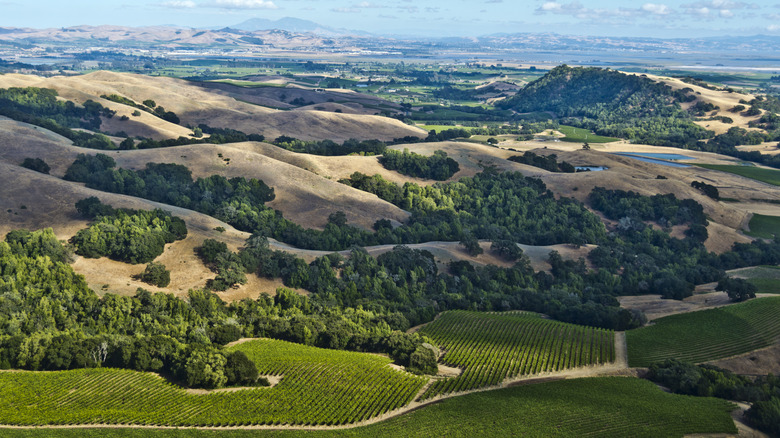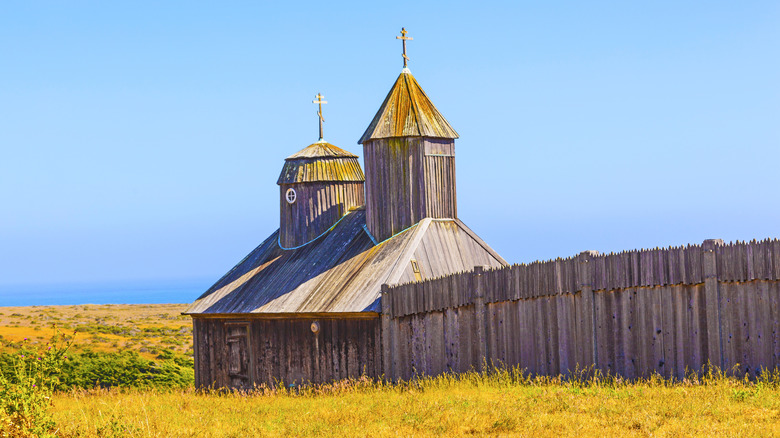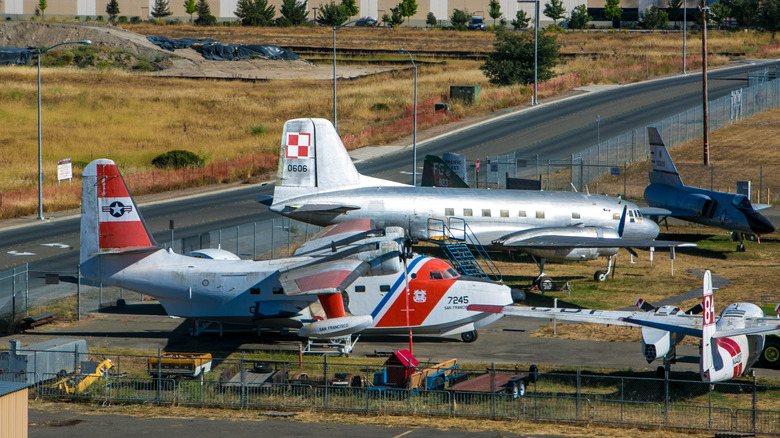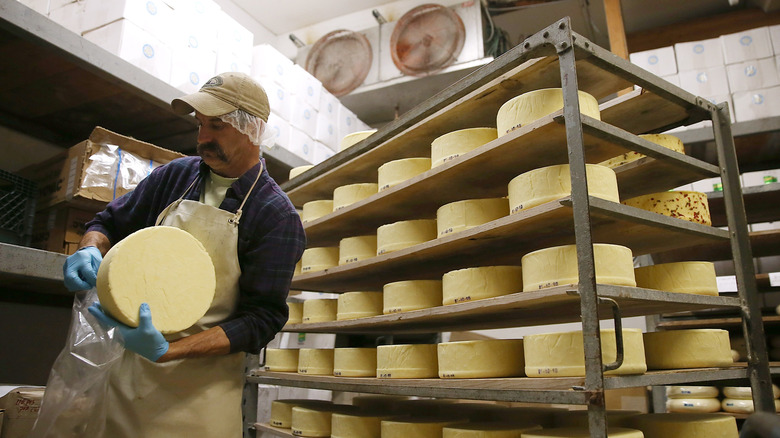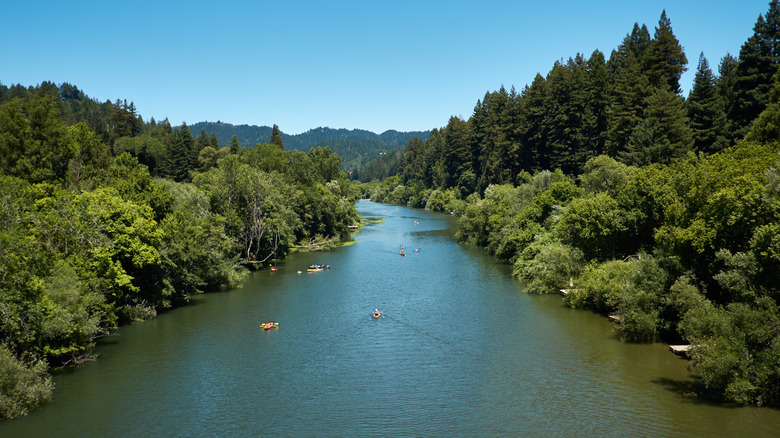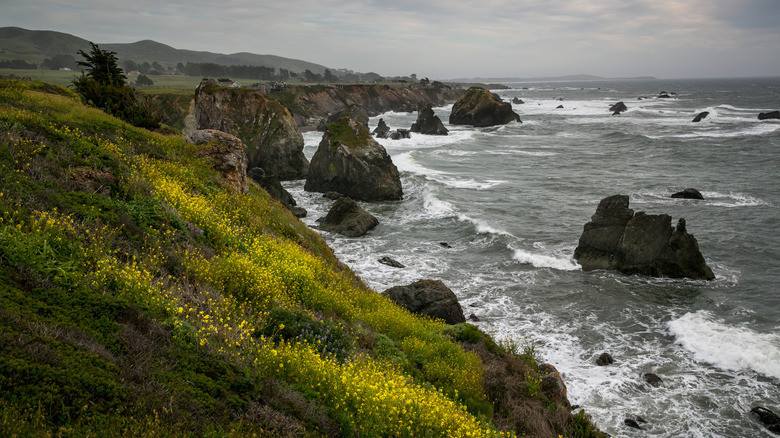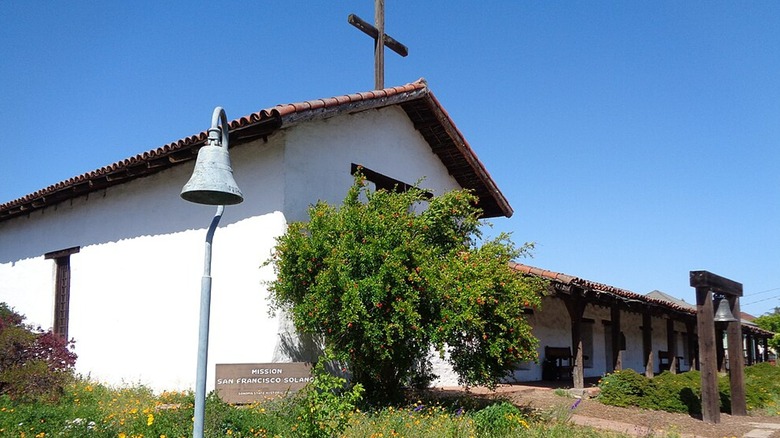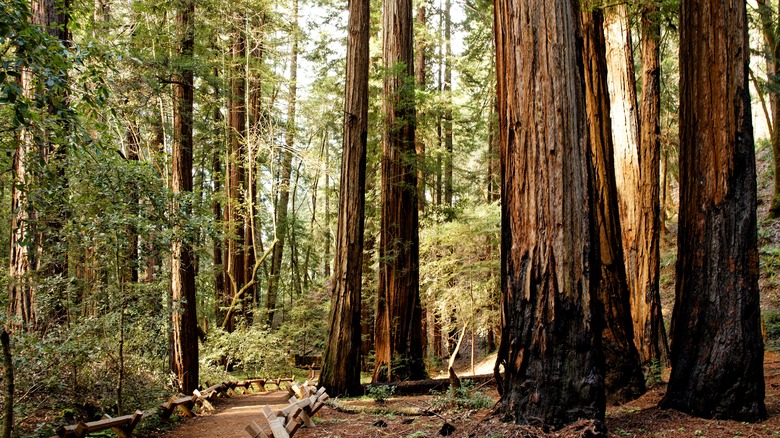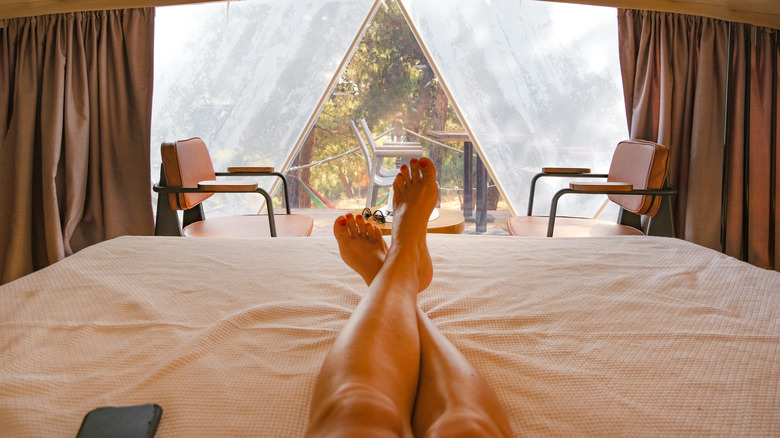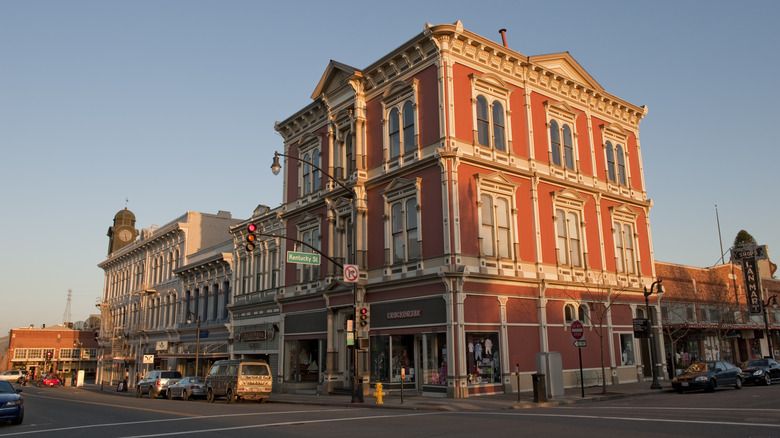The Best Ways To Enjoy California's Iconic Sonoma Wine Country Without Any Wine
Tucked along the northern California coast between Sacramento and Stockton to the east and San Francisco Bay below, Sonoma County is bursting with phenomenal landscapes and more than a few great places to visit. Best known for its vineyards and, therefore, wine-driven tourism activities, winery tours and tasting activities are some of the most prominent things to do in Sonoma.
But this is far from the only draw to coastal, north-central California wine country. Winemaking is, of course, a major business here, but Sonoma is actually wonderfully diverse in its landscape, history, and even architecture. There are plenty of fabulous non-wine-specific activities to partake in Sonoma County that can act as a memorable and rewarding backdrop to a vineyard escape or as a primary set of activities for those looking to explore this magical piece of California coastline without cracking open the booze. From beaches and other majestic waterfront aquatic environs to historic structures dating back to far earlier settlers in the community, there's plenty to sink your teeth into throughout Sonoma beyond just the county's miles of grapes.
Visit Fort Ross, a historic Russian trading encampment
It's perhaps not commonly known to those outside the area, but Sonoma and the wider Northern California Coastline once played host to Russian settlers. In 1812, Ivan Kuskov and a collection of Russian and Aleut traders arrived on the California coast and began construction of what would become Fort Ross. The structures were built from California Redwood and occupy roughly 1 square mile of coastal plateau directly overlooking the ocean. The fort required roughly two years to fully take form but entered service, so to speak, just a few months after the crew began their efforts in the fall of 1812. Fort Ross remains a beautiful example of historic architecture in a state that has seen plenty of settled and transient human activity from time immemorial through to the present.
The fort served the Russian-American Fur Company and acted as an outlet for trade between Russian settlements in what is now the state of Alaska and the Spanish settlers who had claimed much of the California wilds. Much of the fort has been rebuilt over time, with an earthquake, numerous fires, and arson damaging or destroying parts of the overall structure. The site has been under the management of the state since 1906, and so a wonderful timber settlement here remains complete as a snapshot of history, with cannons and all leftover from its earlier days.
Check out the Pacific Coast Air Museum
For those who can't get enough of flights, military aircraft, history, and the wonderful fresh air of the northern California countryside, the Pacific Coast Air Museum is a phenomenal spot to hit while exploring Sonoma. The museum was founded in 1989, and it showcases a collection of aircraft that served in civilian capacities, as well as in combat. Many of the planes found throughout the 3-acre museum field served during Korea and Vietnam, but plenty of newer aircraft can be found spread around the area, too. There are also a number of World War II-era aircraft at the museum for history buffs with a particular affinity for this mighty conflict.
In addition to these other amazing aircraft, the museum is home to the very first responder to the terrorist attacks on September 11th. The "First Responder" F-15A Eagle was indeed the first on the scene, flown by Lt. Col. Tim Duffy, to clear the airspace over New York City after the attacks and sits proudly among the paddock of historical aircraft in Sonoma County. It was placed with the Pacific Coast Air Museum by the Air Force and its own museum operations in 2009. Just outside the city of Santa Rosa, the air museum is a great place to spend an afternoon, climbing around to gawk at some of the most impressive technological marvels that humanity has managed to create. The museum even offers open cockpit days, allowing visitors to climb up into aircraft and get an even more personal experience.
Follow the California Cheese Trail through Sonoma
The California Cheese Trail is a lengthy and oh-so-rewarding voyage through the state's plethora of artisan cheesemakers. Up and down the state (and beyond it, stretching into Arizona and up to Oregon and Washington), over 75 distinct cheese artists are hard at work creating culinary canvasses that delight and burst with flavor. Cheese is a much-loved item to be consumed, largely in the same way that California's wine industry brings in plenty of eager tourists.
A visitor thinking of doing something off the beaten path in Sonoma while still hemming closely to the time-honored tradition of indulging in the region's produce would be wise to consider this culinary adventure. There are seven stops on the trail in Sonoma County alone, with plenty of other choices in its surrounds, including Napa to the east and Tomales just south of Bodega Bay and Valley Ford. The Cheese Trail Map is a great keepsake for visitors who want to sample a bite in one or more creameries; it features 45 Californian cheesemakers.
Not only is the Cheese Trail a fabulous way to find artisanal cheeses and support local farmers and cheesemakers, the trail highlights unique experiences, too. Epicurean Connection in Sonoma offers cheesemaking classes that are tailored to visitors' personal trip. The cheesemakers note their ability to curate a great day out for corporate events, or act as hosts to a baby shower, family gathering, or any other kind of party atmosphere. Group and private classes are on offer, making for a great diversity of choices.
Splash around along the Russian River
The Russian River, much like other similarly named sites, features, and places throughout Sonoma and its surrounds, owes its namesake to Kuskov. The same Russian trader and explorer who founded Fort Ross spent time exploring the waterways and banks of this river just south of the fort's coastal location. The river winds its way through Sonoma County, meeting the Pacific Ocean alongside the town of Jenner and the Sonoma Coast State Park. Plenty of beaches can be found sprawled along the coastline near the river, but the waterway itself is a fantastic recreational space that visitors to Sonoma County will almost assuredly want to check out for themselves.
The river is a slowly meandering water body that peacefully makes its way through Sonoma and down toward the Pacific Coast. As such, kayaking and canoeing — as well as ziplining (which is among the cooler adventure activities found here), are great options for anyone interested in leisurely water sports. Alternatively, there's plenty of opportunity to simply float around in the river's waters for a relaxing day under the sun. There are numerous small towns along the riverbanks, as well. Taking a drive along the feature and stopping in for a bite to eat or a stroll through one of many forested areas can be greatly rewarding.
Go on a California safari at Safari West
Another solid option for travelers to Sonoma is a visit to Safari West (also near the Russian River, making for a quality twofer). Glamping and a South African cultural and culinary experience are just some of the activities offered at this slice of the Savannah plopped down in northern California. Safari West is a 400-acre wildlife preserve focused on conservation and is far from the zoo experience that many people might immediately think of when considering an animal exhibit. Advanced reservations are required, so planning a visit to The Sonoma Serengeti (a great place to visit, especially during the Thanksgiving holidays) before arriving in town is a must.
This adventure is unlike nearly any other you'll find in the United States. For most avid safari enthusiasts, a visit to Africa (perhaps Botswana or Kenya, to name just a few, are some amazing places to explore the grasslands) is a must. There, you'll find myriad national parks and reservation areas teeming with life, and you will enjoy plenty of experiences outside the Savannah that allow for an immersive historical adventure, as well. But for those who can't find the time to make this long voyage, a trip to Sonoma offers a wonderful trek out into the wilds that can rival a full-fledged African safari in many ways. Glamping with giraffes, for instance, is just one of the fabulous options available to visitors.
Take a dip in Bodega Bay
The town of Bodega Bay is a small fishing village situated at the top of Bodega Harbor. The town is blessed with truly breathtaking coastal vistas. The area is brimming with classic views of Pacific power. The sleepy town can see tranquil, pristine waters, or rising tidal intensity that breaks against some of the harbor's rockier shoreline features. Bodega Bay is just off the Shoreline Highway, only a short distance before the roadway changes over into its Coast Highway designation at Salmon Creek, a short hop north.
Bodega Bay makes for an amazing stop for seafood lovers. Plenty of great restaurants dot the coastline on either end of the harbor. Bodega Head juts out into the Pacific on the far extent of the landscape, and watching the vividly motion-filled seascapes and breathing in the salty air is a fabulous way to spend a morning or afternoon. Additionally, this community is an equally phenomenal backdrop when taking in the sunset. As with much of the California coastline, numerous beachheads line the shore, making for a great place to head into the Pacific waters for a refreshing dip!
Explore California heritage at the San Francisco Solano Mission site
Across California, visitors can explore a bastion of the Spanish settlement of the landscape in the form of its Missions. Spanish missionaries built religious communities throughout North America starting in the 1500s. Many sites can be found running up California's coastline (along the El Camino Real — the "King's Highway"— as well as in the larger southwest region and farther south into Mexico. Missions were also established in Florida and Georgia. The San Francisco Solano Mission was the last of these communities built in California, marking the 21st in the state. The establishment is also known as Sonoma Mission since it's located in Sonoma County and, therefore, offers a historical and deeply enjoyable option for visitors looking for something unique to experience beyond the vineyards of Sonoma's rolling hills and valley landscape.
The Mission was named after Saint Francis Solano and was founded in 1823. It was the only Mission constructed after Mexican independence was won from Spain, making the Mission a unique feature among the Spanish footprint in the Americas. The Mission itself was only functional for 11 years, with the Mexican Congress closing down the Mission system in 1834 and repurposing these establishments as parishes instead. By this time, however, Mission San Francisco Solano had been gutted for building materials by the local Sonoma community, and nature had begun to exact its toll. The Mission would perhaps be lost entirely if the site hadn't been purchased by a conservation group in 1903 — restoring the structures to a particular period look and feel for the benefit of the community, reimagining a relic of history that visitors could explore with wonder.
[Featured image by Sarbjit Bahga via Wikimedia Commons | Cropped and scaled | CC BY-SA 4.0]
Hike in Armstrong Redwoods State Natural Reserve
An 805-acre tract of ancient redwood forest, Armstrong Redwoods State Natural Reserve protects monstrous old growth along the California coast. Just north of Guerneville (about halfway between Santa Rosa and Fort Ross), the reserve offers a beautiful landscape ripe for exploration. Sonoma County itself calls Armstrong Redwoods one of its "most peaceful places," and notes that a walk through the towering redwoods is a great way to unwind and practice a bit of mindfulness.
This is perhaps the perfect activity for a visitor to Sonoma looking for a relaxing and rejuvenating stay in the community. Whether you've spent a day or more exploring vineyards or have opted to stick to dry outings entirely rather than cracking open a bottle or two, a hike in the forest is a wonderful way to clear your head and get mentally grounded, ready for whatever life might have in store for you around the corner. Armstrong Redwoods isn't the largest stand of redwoods, but it's a marvel of history, geology, and ecology, nonetheless. The tallest tree is around 310 feet tall, while the oldest dates back more than 1,400 years!
This park is also a somewhat unlikely staple in the community. In 1849, the discovery of widespread gold deposits in the state brought exuberant miners from all over the country, along with others who would take up other entrepreneurial enterprises. All this growth in the coastline's population led to the inevitable need to ramp up building efforts quickly. The result was massive deforestation, culling more than 95% of California's ancient redwood forests in an effort to create the communities that we see in the state today.
Glamping in Wine Country is fabulous, both with wine and without
Glamping has become a major draw for many places around the world. Resorts have cropped up across the globe, but plenty of fabulous glamping destinations can be found in the United States, eliminating the need to break out your passport to enjoy a luxurious outdoor experience. Sonoma County is but one destination rife with glamping sites, but this California coastal community has something special, rocketing it up near the top of many glampers' lists. Whether you're looking for a campsite that includes a taste of the local wineries or not, glamping in Sonoma is a fantastic activity to indulge in. Northern California and the coastal valley geography make for a beautiful night sky, adding a wonderful light show to a visitor's evening after enjoying a great day out in the community — perhaps swimming in one of the county's rivers or exploring Safari West for the day.
Glamping options in Sonoma County include treehouse lodging, iconic airstreams, and safari-themed tents. There are also great sites along the Russian River that pair typical leisure activities like fishing with a beverage or two if you choose. No matter where you choose to lay your head after a day of exploring Sonoma, glamping in the community will bring you closer to nature for a rewarding and immensely relaxing evening. Many glamping sites here cater well to groups rather than single travelers or couples — although smaller cohorts are by no means excluded from a great glamping experience. Considering a group booking at one of the glamping sites makes for a great bonding experience while also helping to reduce the individual cost for travelers staying in Sonoma.
Go antique shopping in trendy Petaluma
Petaluma is a historically rooted staple of Sonoma County. Settled in 1851, Petaluma was built along the banks of the Petaluma River and acted as a shipping hub from its earliest days of settlement. Petaluma retains an iconic and historically vibrant charm, with numerous 19th-century architecture remaining across the community's downtown area. Here, you'll find plenty of farm-to-table restaurants that offer up some of the freshest dishes you'll find anywhere, as well as art galleries, boutique shopping options, and much more. The Petaluma Adobe State Historic Park is a great stop when visiting, showcasing what life might have looked and felt like in Northern California 200 years ago (and it's a National Historic Landmark).
These pale in comparison to the antique shops found throughout Petaluma, though. Around 20 individual dealers operate in the community and stock everything from jewelry and artwork to battlefield equipment (like vintage bayonets). Antique lovers will salivate over the huge selection and varied sellers that have gravitated toward Petaluma to set up shop. An afternoon browsing through vintage gear is well worth a visit, even if you only look and don't end up buying anything.
